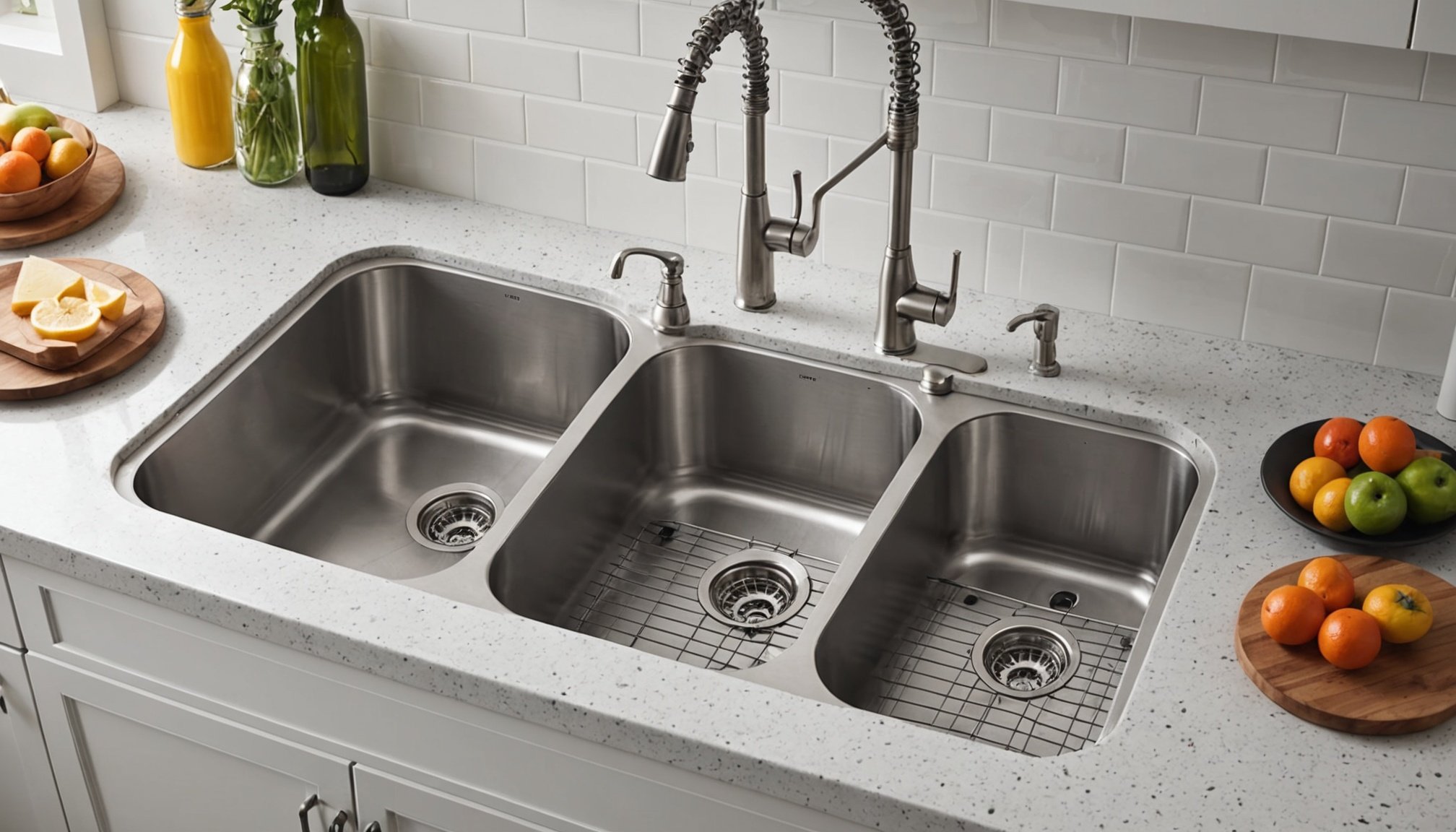Selecting the right kitchen sink size is essential for enhancing both functionality and aesthetic appeal. Every family has unique needs, from cooking styles to daily routines, which can greatly influence your choice. A sink that fits your space and lifestyle can make meal prep and cleanup more efficient. This guide will help you assess your specific requirements, explore various sizes, and ensure that your kitchen sink complements your home perfectly. Finding the ideal balance between practicality and design is just a read away.
Understanding Your Kitchen Space
Designing a kitchen requires a keen understanding of your kitchen dimensions. Accurate measurements are crucial for creating a functional and aesthetically pleasing space. Before diving into design, measuring space ensures that each component fits perfectly, avoiding costly mistakes.
Also read : Transform your kitchen into a fermentation haven: tips for creating your perfect fermentation station
Factors to Consider
When planning, consider the sink placement as a pivotal element. The sink is often the hub of kitchen activity, so its location impacts workflow. Ideally, it should be part of the kitchen triangle, which includes the stove and refrigerator, to maximise efficiency.
Countertop height is another essential factor. Standard heights generally suit most users, but customising this to your needs can enhance comfort and usability. Similarly, cabinet depth plays a significant role in storage capacity and accessibility. Ensure these elements align with your personal requirements and kitchen dimensions.
Have you seen this : Creative Corner Cabinet Storage Ideas: Unlocking Innovative Solutions for Space Optimization
Tools for Effective Planning
Utilising diagrams or digital tools can significantly aid in space planning. These resources help visualise the layout, allowing you to experiment with different configurations. Tools like 3D kitchen planners offer a virtual walkthrough, helping you foresee potential issues and adjust accordingly. This step is invaluable for achieving a well-organised kitchen that meets your needs.
Assessing Family Needs and Lifestyle
Understanding your family size and lifestyle preferences is crucial when designing a kitchen. The number of family members significantly influences the choice of sink. For larger families, a double-bowl sink might be more efficient, accommodating increased dishwashing needs and simultaneous tasks. Conversely, smaller families might benefit from a single-bowl sink, saving space for other kitchen elements.
Cooking Habits and Frequency
Your cooking habits play a pivotal role in kitchen design. If you frequently prepare elaborate meals, ample countertop space and larger sinks can facilitate meal prep and clean-up. For those who prefer quick and simple meals, a compact kitchen layout might suffice, focusing on efficiency and minimalism.
Entertaining and Cleaning Requirements
Lifestyle preferences, such as how often you entertain guests, also impact kitchen design. If hosting is a regular activity, consider additional seating and serving areas. A spacious kitchen island could serve as a hub for social gatherings, while also providing extra workspace. Cleaning requirements should not be overlooked. A family that values a tidy space may opt for easy-to-clean surfaces and efficient storage solutions, ensuring that the kitchen remains uncluttered and functional.
By aligning these elements with your family's unique needs, you can create a kitchen that is both practical and enjoyable to use.
Exploring Sink Sizes and Styles
Choosing the right kitchen sink sizes and sink styles can transform your cooking space into a haven of efficiency and elegance. The variety of design options available caters to different preferences and needs.
Standard Sink Sizes and Their Applications
Standard sink sizes typically range from 24 to 36 inches in width. These dimensions accommodate most kitchen tasks, offering ample space for washing dishes and preparing food. A 30-inch sink is a popular choice, striking a balance between functionality and space conservation.
Popular Styles: Undermount, Farmhouse, Drop-In
Undermount sinks offer a sleek, modern look by being installed beneath the countertop. This style is favoured for its clean lines and easy counter cleaning. Farmhouse sinks, also known as apron-front sinks, provide a rustic charm with their deep basins, ideal for handling large pots and pans. Drop-in sinks are versatile and easy to install, making them a practical choice for various kitchen designs.
Specialty Sinks for Unique Needs
For those with specific cooking or cleaning tasks, specialty sinks offer tailored solutions. Bar sinks, for instance, are smaller and perfect for drink preparation or as an auxiliary sink. Prep sinks provide additional workspace, enhancing multitasking capabilities in busy kitchens. These niche options ensure that every kitchen can cater to its user's unique requirements.
Material Considerations for Kitchen Sinks
Choosing the right sink materials is crucial for balancing aesthetics, durability, and functionality in your kitchen. Each material offers unique benefits and drawbacks, impacting your sink's longevity and maintenance needs.
Common Materials: Stainless Steel, Porcelain, Composite
Stainless steel sinks are a popular choice due to their resistance to rust and stains. They are durable and versatile, fitting well in modern and traditional kitchens. However, they can be prone to scratching and noise. Porcelain sinks offer a classic look and are available in various colours. They are easy to clean but can chip or stain if not maintained properly. Composite sinks, made from granite or quartz, provide a robust and scratch-resistant surface. They are available in multiple colours and textures, offering a unique aesthetic. However, they can be heavier and require more careful installation.
Impact on Sink Size and Installation
The choice of material can influence the sink size and installation process. For instance, heavier materials like porcelain and composite may require additional support and professional installation. Stainless steel, being lighter, is easier to install and more accommodating in various sizes.
Maintenance Tips for Longevity
Proper maintenance ensures your sink remains in top condition. Regular cleaning with mild detergents helps prevent stains and scratches. Avoid harsh chemicals on porcelain to preserve its finish. For composite sinks, using a soft cloth and avoiding abrasive cleaners will maintain their appearance.
Finalizing Your Sink Selection
Choosing the right kitchen sink involves more than just aesthetics; it's about meeting your practical needs. A comprehensive buyer's checklist can streamline this process, ensuring no detail is overlooked. Start by assessing your kitchen's dimensions and the sink's role in your daily activities. Consider the sink size, style, and material that best suit your lifestyle and kitchen layout.
Product Recommendations
When it comes to product recommendations, focus on options that align with your checklist. For those seeking durability and modern appeal, stainless steel sinks are a reliable choice. If you're after a rustic look, farmhouse sinks offer charm and ample space for large cookware. For a seamless countertop integration, undermount sinks provide a sleek finish.
Installation Tips
Proper installation is crucial for your sink's longevity and functionality. While some may opt for DIY, professional assistance ensures precision and avoids potential mishaps. Heavier sinks, such as those made from porcelain or composite materials, often require expert installation to provide the necessary support. Always verify that your chosen sink fits your existing plumbing configuration to prevent costly adjustments. By following this purchasing guidance, you can confidently select a sink that complements your kitchen's design and meets your functional needs.











